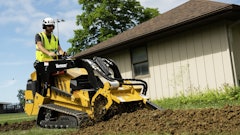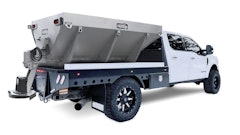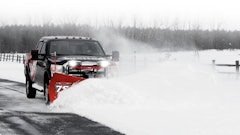
Jim Johnson of Johnson Seasonal Services in Auburn Hills, MI, has been in the snow-removal business for more than 10 years. He doesn't necessarily want to be the biggest company around, but he does want to be the best. "We want to be the Apple of snow removal," Johnson says. "We want to create an experience, not just provide a service."
To rise to the top of the snow-removal business, you have to be reliable and consistent. But you also have to be proactive and innovative, which is why Johnson places considerable emphasis on technology, training and process improvement.
Johnson Seasonal Services also provides landscape design, maintenance and irrigation services, in addition to excavation. But Johnson's passion is snow and ice management. The company services a variety of commercial and industrial properties that include hospitals, colleges, school districts, manufacturing plants and retail centers. These are high-traffic areas which require the best in snow and ice management. These sites are also big … really big. "Most of the sites we service have at least 5 acres of parking lots, and some are closer to 20," Johnson says. "We also have miles and miles of sidewalks."
Keeping an eye on productivity
One plus is that the majority of Johnson's client sites are within a four-mile radius of his company's headquarters. "We can shuffle equipment from site to site pretty easily," he points out. "That's important because I'm big on equipment efficiency."
Johnson had brought in consultants and attended seminars over the years in an effort to get his arms around equipment efficiency rates. For example, how many acres should a wheel loader with 14-foot containment plow be able to clear per hour? The problem was that the generally accepted rates weren't matching up to Johnson's reality.
So Johnson bought several GoPro cameras and mounted them in his trucks and equipment. This lets him monitor each operator's actual production to establish his own real-life equipment efficiency rates. "I time-lapse the video, and then go back to our software to measure the area that the operator completed during that timeframe," Johnson explains. "Every operator is different. My efficiency rate, for instance, will be much different than someone I just hired. I need to make sure that I'm bidding jobs at realistic rates."
On that note, Johnson says the GoPro cams have aided in his training efforts. He does have an extensive training regimen in place. But the GoPro footage has helped to expose instances where additional training could be necessary, while also exposing opportunities to improve processes and drive productivity. "Our employees are well aware of what we're doing and completely understand it," Johnson says. "We're just trying to keep getting better."
Technology renders data, and data helps reduce risk
Through the use of cutting-edge technology like this, Johnson Seasonal Services is able to provide not only unmatched service, but also liability protection by validating each and every service visit with a detailed report. Slip-and-fall accidents are a huge issue for companies and property managers, along with their snow contractors. Johnson refuses to accept the premise that "eventually there will be an accident." He'd rather focus on doing everything in his power to prevent one from happening.
Better forecasting. Ambient air temperature gauges are on each of Johnson's trucks. That's great, but not enough, according to Johnson. The air temperature alone won't tell you if ice will begin accumulating on the ground. So Johnson has begun experimenting with laser temperature guns to read ground temperatures.
"It can be 32° outside in April," Johnson says, "so when the snow hits the ground, it melts. But if it's 36° in January, that snow or rain probably turns to ice. One of the toughest decisions a snow contractor has is when to make the call to treat. Taking ground temperatures is helping us do that more effectively."
For example, Johnson says that pre-wetting salt is a very effective method of surface treatment. But the operator needs to know when to use it. "From 32° to 27°, there is no reason to pre-wet because it won't do you any good," Johnson says. "If the ground temp is around 20° or lower, though, it's vital to use the pre-wet." Knowing both ambient temperature and ground temperature is critical.
Right now operators are simply alerted to the two temperatures by a digital monitor in the cab. However, Johnson is working on an electrical system that would automatically activate the pump (pre-wet system) when conditions call for it.
Monitoring jobs. Johnson's tracking system provides complete control over his entire operation at all times. "We have the ability to monitor real-time progress of a property being serviced, giving us eyes on our entire operation," he says. The GoPro cameras play a role here. So do his GPS-enabled trucks and the utilization of geo-fencing technology. Johnson knows when a truck enters a property, how long it's there, and when it leaves. He's also able to monitor progress for his entire portfolio of sites during a snow event. "If I feel like we're getting behind, we can call in reinforcements or shuffle equipment around to get caught up," he says.
Reporting. Because Johnson's process is so automated, providing the client with up to date information is seamless. Clients can have a report sent to them via email or text message. They can also choose between different types of reports, such as when a crew enters their site, updates at different stages during a snow event, when a crew exits a site, and a post-event report.
"I'm big on risk management," Johnson reminds. "All of this technology and data help us validate what we're doing."
Extra services and lessons from farmers
For several years, as a way to say "thank you" to clients, Johnson hired a subcontractor to sweep parking lots at the end of winter to clean up salt and other debris. But eventually many of Johnson's clients began requesting this as a staple service, sometimes on a monthly if not weekly basis. So Johnson has decided to bring his sweeping service in-house. A friend down in South Carolina alerted Johnson to a sweeper truck for sale on government auction this past spring. Johnson bought the truck, a Johnston Sweeper, at a bargain price. It has everything he wanted: high capacity, an overhead boom, on-board water system for scrubbing, and a vac tube.
Johnson takes pride in the fact that he's using some "unconventional" tools and equipment. Aside from the GoPro cameras, laser temperature guns and sweeper truck, he's also experimenting with farm tractors in lieu of the more traditional wheel loaders and skid-steer loaders.
"I come from a farm background," Johnson relates. "Tractors are fast, and have plenty of horsepower and hydraulic power. I also think tractors can be more versatile. The secret for me has been leasing them from farmers who aren't using them all winter. We do own one tractor but lease several others. We use snow pushers (i.e. containment plows, box plows) and dozer blades on them."
Now Johnson is testing high-capacity, truck-mounted fertilizer tenders as a more efficient means to get salt on site. Early results are cause for optimism. "The augers are having no issues with feeding salt," Johnson says. "Now I just have to set up my tractors with spreaders so it all comes together."



![Kubota Snow ah3 Sgv25ua[1]](https://img.greenindustrypros.com/mindful/acbm/workspaces/default/uploads/2025/10/kubota-snowah3sgv25ua1.bAUoUSziui.png?auto=format%2Ccompress&bg=fff&fill-color=fff&fit=fill&h=100&q=70&w=100)




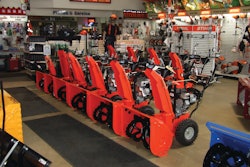
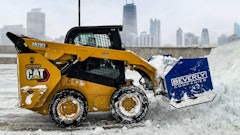

![Kubota Snow ah3 Sgv25ua[1]](https://img.greenindustrypros.com/mindful/acbm/workspaces/default/uploads/2025/10/kubota-snowah3sgv25ua1.bAUoUSziui.png?ar=16%3A9&auto=format%2Ccompress&bg=fff&fill-color=fff&fit=fill&h=135&q=70&w=240)



